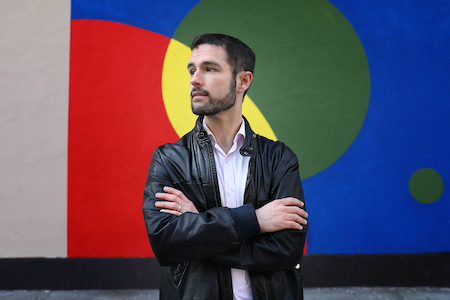Dec 9, 2025 12:28 PM
In Memoriam: Gordon Goodwin, 1954–2025
Gordon Goodwin, an award-winning saxophonist, pianist, bandleader, composer and arranger, died Dec. 8 in Los Angeles.…

“I enjoyed exploring different techniques with this music,” Yeager says.
(Photo: Chris Rukker)Kurt Vonnegut, the late, great American novelist and iconoclast, was many things: satirist, science fictional soothsayer, witty social commentator and friendly absurdist. He was also a fiendish fan of music, and, particularly jazz. Once he wrote, “Historians in the future, in my opinion, will congratulate us on very little other than our clowning and jazz.”
Vonnegut’s influence has been directly channeled by musicians before, but rarely with the depth, dedication and imagination of pianist-composer Jason Yeager’s ambitious new album Unstuck In Time: The Kurt Vonnegut Suite. The album is being released on what would be the centennial birthday of Vonnegut (who passed in 2007). Live performances include a birthday-timed concert at the Kurt Vonnegut Museum and Library in the author’s hometown of Indianapolis on Nov. 11.
As a teenager, Yeager started reading his father’s Vonnegut novels and “couldn’t put them down. They hit me viscerally, throwing me into fits of laughter, astounding me with how wildly imaginative they are, and inspiring me with their darkly funny social criticism and humanity.” Fast-forward to today, and he has crafted his elaborate valentine to Vonnegut, in musical terms.
Yeager points out that there have been other Vonnegut tributes in the jazz sphere. British pianist John Taylor penned the tunes “Ice 9” and “So It Goes,” and Indianapolis guitarist Charlie Ballantine released Vonnegut, an entire album in homage the author.
Yeager’s grand design of a suite began back in 2013, when he wrote a piece riffing off of the novel Slaughterhouse Five. “I decided to write a blues inspired by the protagonist, Billy Pilgrim, and use Vonnegut’s refrain of ‘so it goes’ for the opening motif.” In time, Yeager composed other pieces, including the Cat’s Cradle-inspired “Bokonon,” and “Unk’s Fate,” triggered by Sirens of Titan.
Yeager explains that “slowly but surely, I amassed a collection of free-standing Vonnegut songs, but much to my delight they shared a certain spirit in common, and even some musical motifs. I didn’t mean for it to become a suite, but it did. Blame it on the Tralfamadorians.”
He’s referring to the alien beings found in many Vonnegut books, cosmic puppeteers in charge of humanity’s doings, alluded to with the album’s finale, “Tralfamadorian Rhapsody.”
Learning about the impending centennial supplied a necessary impetus to complete the suite. As he recalls, “I thought, ‘I have to get moving, and finish this in time for KV’s 100th.’”
Yeager opted to score the music for a septet, with two special cameos by alto saxophonist Miguel Zenón, whom Yeager has greatly respected and consulted with during the writing process. (“It was a dream come true for me to get to work with him,” he commented).
Though Unstuck In Time is almost entirely instrumental, the spoken word interlude “So it Goes” — recorded in multiple overdubs — appears at midpoint, as if checking in directly with an iconic slice of Vonnegut vocabulary.
“I enjoyed exploring different techniques with this music — setting the rhythms or patterns of actual text to music, taking general character portraits through music, or evoking the feeling or ambience of a scene as I experienced it while reading, almost as though I were writing a film score for a book.”
He makes a reasonable case for parallels between Vonnegut and another of Yeager’s heroes. “Sometimes I do feel like his phrasing, his rhythm and his bucking convention is almost a literary parallel to Thelonious Monk,” Yeager comments. “Both Monk and Vonnegut were rooted in profound artistic traditions yet weren’t constrained by them. Finally, both artists were met with frustration and obscurity earlier on, only receiving critical and popular acclaim after a couple decades into their artistic careers.”
On Yeager’s goals for Unstuck In Time, he asserts, “I hope this album inspires people to read Vonnegut. And I also hope it gets Vonnegut fans interested in this music.” DB

Goodwin was one of the most acclaimed, successful and influential jazz musicians of his generation.
Dec 9, 2025 12:28 PM
Gordon Goodwin, an award-winning saxophonist, pianist, bandleader, composer and arranger, died Dec. 8 in Los Angeles.…

Flea has returned to his first instrument — the trumpet — and assembled a dream band of jazz musicians to record a new album.
Dec 2, 2025 2:01 AM
After a nearly five-decade career as one of his generation’s defining rock bassists, Flea has returned to his first…

Belá Fleck during an interview with Fredrika Whitfield on CNN.
Jan 13, 2026 2:09 PM
The fallout from the renaming of the John F. Kennedy Center for the Performing Arts to include President Donald…

“It’s a pleasure and an honor to interpret the music of Oscar Peterson in his native city,” said Jim Doxas in regard to celebrating the Canadian legend. “He traveled the world, but never forgot Montreal.”
Nov 18, 2025 12:16 PM
In the pantheon of jazz luminaries, few shine as brightly, or swing as hard, as Oscar Peterson. A century ago, a…

Dec 11, 2025 11:00 AM
DownBeat presents a complete list of the 4-, 4½- and 5-star albums from 2025 in one convenient package. It’s a great…